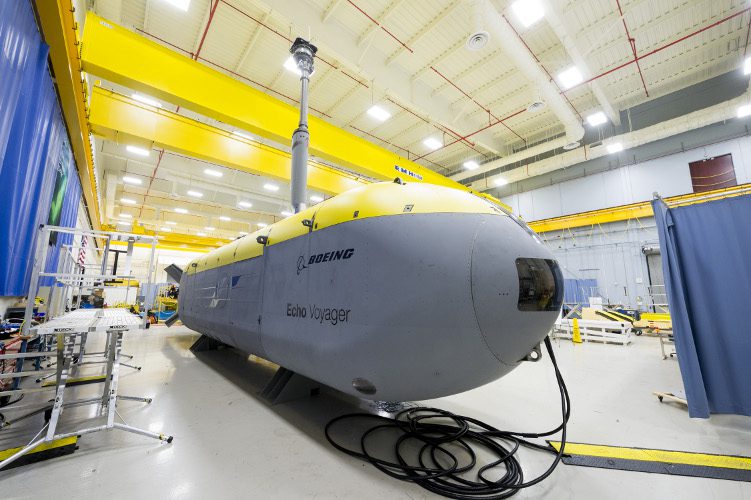Boeing Co. is expected to deliver Orca –an underwater drone the size of a subway car that’s envisioned to lay mines and perform other missions for the US Navy — as much as three years later than planned.
As the Navy works to incorporate pilotless ships in its future fleet, budget documents show the first of five operational Orca drones may be delivered in September 2023, rather than December 2020, “due to contractor challenges and supplier issues.”
Boeing beat out aerospace rival Lockheed Martin Corp. for the project in February 2019. Boeing’s $274 million fixed-price contract requires the company to absorb overruns above a certain threshold.
“The Navy is working with Boeing to mitigate schedule delays and execute risk reduction” by paying for a prototype that’s being used for testing and training, the service said. The test drone was christened April 28 and began its first in-water testing.
Boeing’s ability to complete work on Pentagon contracts on time and to promised specifications is being scrutinized after the company recorded more than $1.3 billion in charges in the first quarter for cost overruns on fixed-price defense contracts including the new Air Force One, the KC-46 tanker programs and the Navy’s MQ-25 aerial refueling drone.
Boeing has continued investing in futuristic unmanned technologies in the air and sea as it addresses delays and quality lapses in conventional airplane programs like the 777X jetliner, whose market entry has been delayed by five years to 2025.
“Development work comes with uncertainties and variability in terms of cost and time estimates required to develop new, advanced technology,” Boeing said in a statement on the 70-ton Orca’s delay. “We also experienced Covid-related impacts during the stand-up of the new industrial base and supply chain necessary to enter system production” so “delivery of the first operational vehicle, which was slated for the end of 2020, was delayed.”
Asked if Boeing anticipated taking a charge on Orca, the company said “as always, we’ll evaluate the financial position of all our programs during our normal quarterly closing process.”
Boeing has “worked diligently to stand up a new industrial base and supply chain for titanium composites, pressure vessel manufacturing” at efficient production rates and “batteries necessary to enter production” on the Orca system, the Naval Sea Systems Command said in a statement.
The command didn’t address why these production challenges weren’t anticipated before Boeing’s award over Lockheed. Nor did it address what cost growth the delays and production issues have caused.
The hulking underwater drones that Boeing is manufacturing jointly with shipbuilder Huntington Ingalls Industries Inc. build on decades of cutting-edge research into manned and unmanned submarines by Boeing as well as defense programs that it acquired from Rockwell International Inc. in 1996.
The Orca is based on Boeing’s 50-ton Echo Voyager, an experimental drone that was designed to cruise underwater for months at depths of as much as 11,000 feet (3,400 meters) on anti-submarine, mine-sweeping and other missions.
“The one place they’ve had some success organically and through acquisitions is through remotely piloted vehicles and unmanned vehicles,” said Richard Aboulafia, an analyst with AeroDynamic Advisory. “If they can’t do that well either, that’s a problem.
Drone Ambitions
Orca is the largest of several classes of unmanned underwater surface and surface vessels that Navy officials were developing in the Trump administration’s final years in the effort to boost the service’s total inventory from 298 deployable vessels today to as many as 355 by 2030. The Biden administration hasn’t endorsed the Trump number nor proposed a new goal. But the Navy continues to see value in unmanned vessels, as outlined in a March 2021 framework. The service’s shipbuilding plan has budgeted more than $4 billion through 2027 on pilotless systems.
Orca’s technical issues are likely to be repeated as the service pursues unmanned systems, according to Shelby Oakley, a Government Accountability Office acquisition director who has followed the issue. “The Navy is in the beginning phases of developing uncrewed systems and, like all new technical endeavors, is likely to face some challenges,” she said.
“The Navy can improve the development by changing its management approach and better planning its strategy for transitioning its prototyping efforts,” she said. “We are currently in the process of reviewing the challenges facing” the Orca program “and plan to report on the Navy’s path forward this summer.”
Loren Thompson, an analyst for the Lexington Institute, said “the expectation is that Orca will eventually be able to perform mine-laying, mine countermeasures, intelligence-gathering, antisubmarine operations and electronic warfare missions” and maybe even conduct strike operations against surface targets at sea and on land.
Thompson, whose think tank takes contributions from Boeing, said “Orca could be the leading edge of a revolution at sea.
Source: gCaptain






